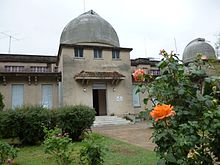Argentine National Observatory
This article does not cite any sources. (July 2021) |
 | |
| Alternative names | Astronomical Observatory of Cordoba |
|---|---|
| Organization | National University of Córdoba |
| Observatory code | 822 |
| Location | Córdoba Province, Argentina |
| Coordinates | 31°25′17″S 64°11′56″W / 31.4214°S 64.1989°WCoordinates: 31°25′17″S 64°11′56″W / 31.4214°S 64.1989°W |
| Established | 1871 |
| Website | www |
 Location of Argentine National Observatory | |

The Argentine National Observatory, today the Astronomical Observatory of Córdoba, was founded on 24 October 1871, by Argentine president Domingo F. Sarmiento and the North American astronomer Benjamin Apthorp Gould.
History[]
Its creation was the beginning of astronomical studies in Argentina. When President Domingo F. Sarmiento was representing his country in the United States, he had the opportunity to meet pioneering astronomer Benjamin Apthorp Gould, who was very interested in traveling to Argentina in order to study the stellar south hemisphere.
Once Sarmiento was installed as President of Argentina, he Gould to travel to Argentina, in 1869, to provide his full support to organize an observatory. Gould arrived in Buenos Aires in 1870. The same night of the inauguration of the Astronomical Observatory of Córdoba, Gould began with the naked eye, and later with the aid of small binoculars, a map of the southern sky, recording more than 7000 stars, which was published under the name of Uranometría Argentina. He remained as director of the observatory until 1885, when he returned to the United States.
The first stellar photographs in the world – hundreds of sheets of open star clusters – were taken at this observatory. This helped to determine the exact position of each star. Gould published the results in the Catálogo de zonas estelares (1884), the first systematic and large-scale astronomy book, including more than 70,000 stars of the southern hemisphere, and the Argentinian General Catalog, which contains about 35,000 stars. The Catálogo de zonas estelares was republished in 1897 under the title Fotografías Cordobesas.
See also[]
References[]
External links[]
- (in Spanish) [1] The Astronomical Observatory of Córdoba
- (in Spanish) Visita a la Estación Astrofísica de Bosque Alegre
- (in Spanish) [2] Santiago Paolantonio and Edgardo R. Minniti, 'Fotografías Cordobesas: obra pionera.'
- Astronomical observatories in Argentina
- 1871 establishments in Argentina
- Buildings and structures in Córdoba, Argentina
